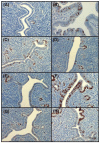Diarylheptanoid phytoestrogens isolated from the medicinal plant Curcuma comosa: biologic actions in vitro and in vivo indicate estrogen receptor-dependent mechanisms
- PMID: 19654927
- PMCID: PMC2717144
- DOI: 10.1289/ehp.0900613
Diarylheptanoid phytoestrogens isolated from the medicinal plant Curcuma comosa: biologic actions in vitro and in vivo indicate estrogen receptor-dependent mechanisms
Abstract
Background: Diarylheptanoids isolated from Curcuma comosa Roxb. have been recently identified as phyto estrogens. However, the mechanism underlying their actions has not yet been identified.
Objectives: We characterized the estrogenic activity of three active naturally occurring diarylheptanoids both in vitro and in vivo.
Methods: We characterized mechanisms of estrogenic action of the diarylheptanoids (3S)-1,7-diphenyl-(6E)-6-hepten-3-ol (D1), 1,7-diphenyl-(6E)-6-hepten-3-one (D2), and (3R)-1,7-diphenyl-(4E,6E)-4,6-heptadien-3-ol (D3) by using a real-time polymerase chain reaction assay, a mammalian transfection model, and a uterotrophic assay in mice.
Results: All diarylheptanoids up-regulated estrogen-responsive genes in estrogen-responsive breast cancer cells (MCF-7). In HepG2 cells transfected with estrogen receptor (ER) beta or different ERalpha functional receptor mutants and the Vit-ERE-TATA-Luc reporter gene, all diarylheptanoids induced transcription through a ligand-dependent human ERalpha-ERE-driven pathway, which was abolished with ICI 182,780 (ER antagonist), whereas only D2 was active with ERbeta. An ERalpha mutant lacking the functional AF2 (activation function 2) region was not responsive to 17beta-estradiol (E(2)) or to any of the diarylheptanoids, whereas ERalpha lacking the AF1 domain exhibited wild-type-like activity. D3 markedly increased uterine weight and proliferation of the uterine epithelium in ovariectomized mice, whereas D1 and D2 were inactive. D3, like E(2), up-regulated lactoferrin (Ltf) gene expression. The responses to D3 in the uterus were inhibited by ICI 182,780. In addition, D3 stimulated both classical (Aqp5) and nonclassical (Cdkn1a) ER-mediated gene regulation.
Conclusions: The results suggest that the D3 diarylheptanoid is an agonist for ER both in vitro and in vivo, and its biological action is ERalpha selective, specifically requiring AF2 function, and involves direct binding via ER as well as ERE-independent gene regulation.
Keywords: Curcuma comosa; ER dependent; ERE dependent; ERE independent; diarylheptanoid; estrogen-regulated genes; uterotrophic activity.
Figures







Similar articles
-
Estrogenic activity of diarylheptanoids from Curcuma comosa Roxb. Requires metabolic activation.J Agric Food Chem. 2009 Feb 11;57(3):840-5. doi: 10.1021/jf802702c. J Agric Food Chem. 2009. PMID: 19143535
-
The natural estrogenic compound diarylheptanoid (D3): in vitro mechanisms of action and in vivo uterine responses via estrogen receptor α.Environ Health Perspect. 2013 Apr;121(4):433-9. doi: 10.1289/ehp.1206122. Epub 2013 Jan 18. Environ Health Perspect. 2013. PMID: 23552522 Free PMC article.
-
Diarylheptanoids, new phytoestrogens from the rhizomes of Curcuma comosa: Isolation, chemical modification and estrogenic activity evaluation.Bioorg Med Chem. 2008 Jul 15;16(14):6891-902. doi: 10.1016/j.bmc.2008.05.051. Epub 2008 May 28. Bioorg Med Chem. 2008. PMID: 18554915
-
Estrogen Hormone Biology.Curr Top Dev Biol. 2017;125:109-146. doi: 10.1016/bs.ctdb.2016.12.005. Epub 2017 Feb 3. Curr Top Dev Biol. 2017. PMID: 28527569 Free PMC article. Review.
-
New insights into the classical and non-classical actions of estrogen: evidence from estrogen receptor knock-out and knock-in mice.Mol Cell Endocrinol. 2008 Aug 13;290(1-2):24-30. doi: 10.1016/j.mce.2008.04.003. Epub 2008 Apr 20. Mol Cell Endocrinol. 2008. PMID: 18534740 Free PMC article. Review.
Cited by
-
ASPP 092, a phenolic diarylheptanoid from Curcuma comosa suppresses experimentally-induced inflammatory ear edema in mice.Saudi J Biol Sci. 2021 Oct;28(10):5937-5946. doi: 10.1016/j.sjbs.2021.06.056. Epub 2021 Jun 24. Saudi J Biol Sci. 2021. PMID: 34588910 Free PMC article.
-
Evaluation of Estrogenic Activity of Extract from the Herbal Mixture Cynanchum wilfordii Hemsley, Phlomis umbrosa Turczaninow, and Angelica gigas Nakai.Toxicol Res. 2017 Jan;33(1):71-77. doi: 10.5487/TR.2017.33.1.071. Epub 2017 Jan 15. Toxicol Res. 2017. PMID: 28133516 Free PMC article.
-
Unveiling the anticancer potential of Curcuma amada rhizome extract against prostate cancer through computational and experimental approaches.Sci Rep. 2025 Jul 9;15(1):24739. doi: 10.1038/s41598-025-10761-0. Sci Rep. 2025. PMID: 40634475 Free PMC article.
-
Development of phenotypic and transcriptional biomarkers to evaluate relative activity of potentially estrogenic chemicals in ovariectomized mice.Environ Health Perspect. 2015 Apr;123(4):344-52. doi: 10.1289/ehp.1307935. Epub 2015 Jan 9. Environ Health Perspect. 2015. PMID: 25575267 Free PMC article.
-
Unique Sensitivity of Uterine Tissue and the Immune System for Endometriotic Lesion Formation.Front Physiol. 2021 Dec 17;12:805784. doi: 10.3389/fphys.2021.805784. eCollection 2021. Front Physiol. 2021. PMID: 34975547 Free PMC article.
References
-
- Brzozowski AM, Pike AC, Dauter Z, Hubbard RE, Bonn T, Engstrom O, et al. Molecular basis of agonism and antagonism in the oestrogen receptor. Nature. 1997;389:753–758. - PubMed
-
- Chun KS, Sohn Y, Kim HS, Kim OH, Park KK, Lee JM, et al. Anti-tumor promoting potential of naturally occurring diarylheptanoids structurally related to curcumin. Mutat Res. 1999;428:49–57. - PubMed
-
- Couse JF, Curtis SW, Washburn TF, Lindzey J, Golding TS, Lubahn DB, et al. Analysis of transcription and estrogen insensitivity in the female mouse after targeted disruption of the estrogen receptor gene. Mol Endocrinol. 1995;9:1441–1454. - PubMed
Publication types
MeSH terms
Substances
Grants and funding
LinkOut - more resources
Full Text Sources
Other Literature Sources
Miscellaneous

